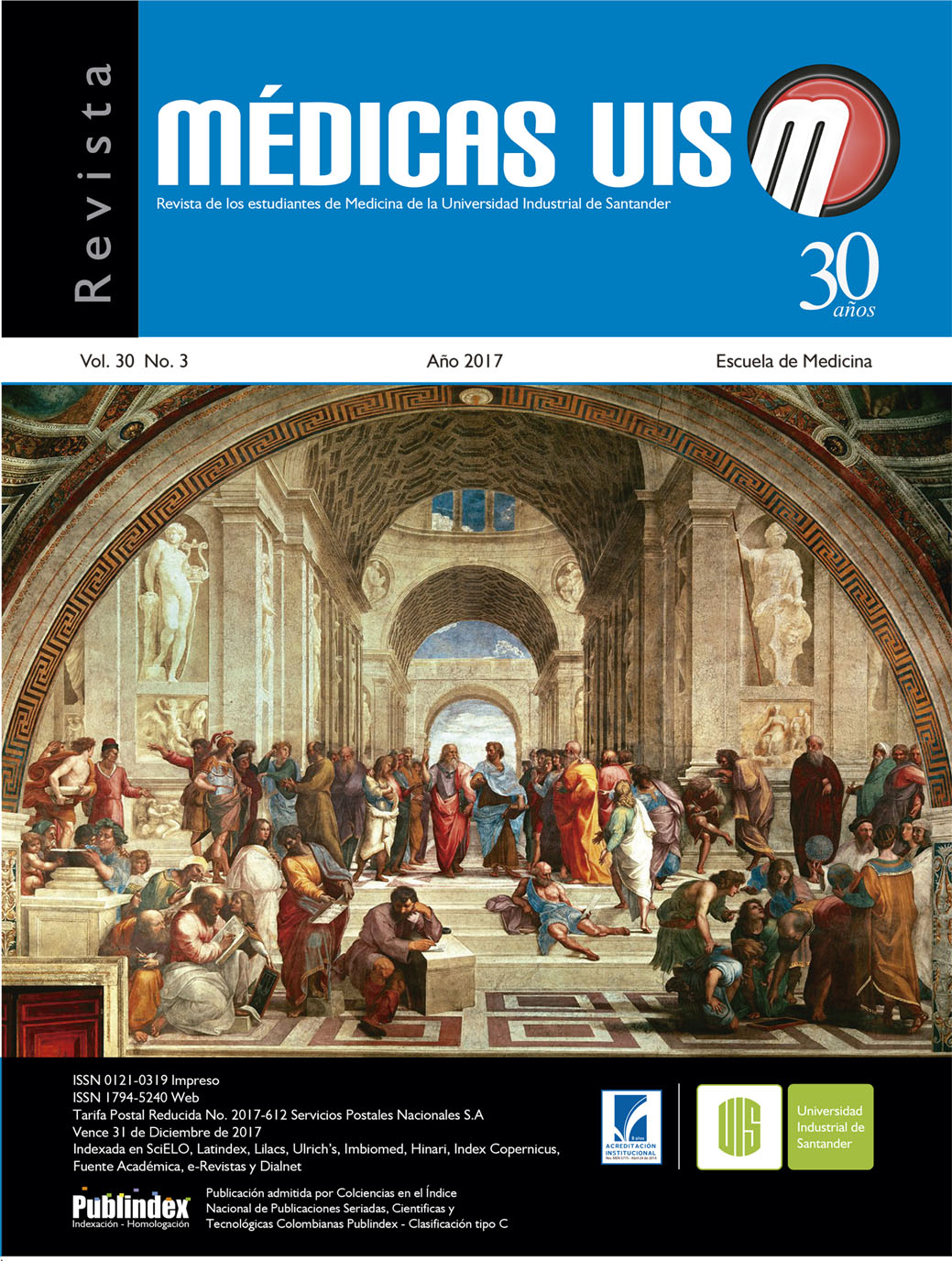Abstract
Introduction: the oral feeding after birth is carried out by proper coordination of the functional suction-swallow-breathing triad; however, when there is a dysfunction in any of the variables, the suction-swallowing disorders are presented. There are several factors which predetermines the presence of these disorders, one of them is prematurity which delays the acquisition of coordination and development of each function of the triad. Objective: to determine the prevalence of suction-swallowing disorder in preterm infants born at the University Hospital of Santander according to the degree of prematurity as well as the associated variables. materials and methods: observational cross-sectional study. A clinical history review of preterm neonates at the University Hospital of Santander during 2016, including a total of 115 patients, was carried out. Results: patients with a diagnosis of swallowing disorder had significantly lower mean gestational age, weight and height compared to the group of patients who did not present this disorder, as well as longer hospital stays. Variables such as hypertension associated with pregnancy, maternal infection at the time of delivery, abruptio of placenta, cesarean delivery, respiratory distress syndrome, sepsis and neonatal jaundice, ileus and anemia were found to be higher in patients with swallowing disorder. Conclusions: there are variables that are associated with suction-swallowing disorder, which must be identified and intervened
to mitigate the burden of the disease. MÉD.UIS. 2017;30(3):73-81.
References
3. Palencia A. Parto prematuro. Sociedad colombiana de pediatría. 2009;9(4):10-9.
4. DANE [Internet]. Nacimientos 2016 – Preliminar. Cifras con corte a 31 de marzo de 2017 (publicadas el 30 de junio de 2017). Nacimientos por área de ocurrencia y sexo, según grupos de edad de la madre, total nacional [Citado 15 Jul 2017]. Disponible en: https://www.dane.gov.co/index.php/estadisticas-por-tema/salud/nacimientos-y-defunciones/nacimientos/nacimientos-2016
5. Merritt TA, Pillers D, Prows SL. Early NICU discharge of very low birth weight infants: A critical review and analysis. Semin Neonatol. 2003;8(2):95–115.
6. O’Shea TM, Klinepeter KL, Goldstein DJ, Jackson BW, Dillard RG. Survival and developmental disability in infants with birth weights of 501 to 800 grams, born between 1979 and 1994. Pediatrics. 1997;100(6):982–6.
7. Campos-montero ZI. Problemas de la alimentación en lactantes. Segunda parte : fases oral y faríngea. Acta pediatría costarricense. 2010;(22)1:14–22.
8. La Orden Izquierdo E, Salcedo Lobato E, Cuadrado Pérez I, Herráez Sánchez MS, Cabanillas Vilaplana L. Retraso de la adquisición de la succión-deglución-respiración en el pretérmino; efectos de una estimulación precoz. Nutr Hosp. 2012;27(4):1120–6.
9. Fucile S, Gisel E, Lau C. Oral stimulation accelerates the transition from tube to oral feeding in preterm infants. J Pediatr [Internet]. 2002 [Citado 15 Jul 2017]; 141(2):230.
10. Maastrup R, Hansen BBM, Kronborg H, Bojesen SN, Hallum K, Frandsen A, et al. Breastfeeding progression in preterm infants is influenced by factors in infants, mothers and clinical practice: the results of a national cohort study with high. PLoS One [Internet]. 2014 [Citado 15 Jul 2017];9(9):e108208. Available from: http://dx.plos.org/10.1371/journal.pone.0108208
11. Hardy W. Evidence-Based Practice Brief: Promoting breastfeeding in NICU. Adv Neonatal Care [Internet]. 2010 [Citado 15 Jul 2017];10(1):40. Available from: https://www.ncbi.nlm.nih.gov/pubmed/20150781
12. Johnson AN. Engaging fathers in the NICU: taking down the barriers to the baby. J Perinat Neonatal Nurs [Internet]. 2008 [Citado 15 Jul 2017];22(4):302–6. Available from: http://www.ncbi.nlm.nih.gov/pubmed/19011495
13. Golianu B, Krane E, Seybold J, Almgren C, Anand KJS. Non-Pharmacological Techniques for Pain Management in Neonates. Semin Perinatol [Internet]. 2007 [Citado 15 Jul
2017];31(5):318–22. Available from: http://dx.doi.org/10.1053/j.semperi.2007.07.007
14. Alcaldía de Bucaramanga. Plan de Desarrollo 2016-2019. Planes y proyectos (publicadas en 2016) [Citado 15 Jul 2017]. Disponible en: http://versionantigua.bucaramanga.gov.co/documents/dependencias/PLAN_COMPLETO_2016-2019.pdf
15. Blencowe H, Cousens S, Oestergaard M, Chou D, Moller AB, Narwal R, et al. National, regional and worldwide estimates of preterm birth rates in the year 2010 with time trends since 1990 for selected countries: a systematic analysis and implications. The Lancet [Internet]. 2012 [Citado 15 Jul 2017]; 379(9832):2162-72. Disponible en: http://www.thelancet.com/journals/lancet/article/PIIS0140-6736(12)60820-4/abstract
16. Adams-Chapman I, Bann CM, Vaucher YE, Stoll BJ. Association between feeding difficulties and language delay in preterm infants using bayley scales of infant development-third edition. J Pediatr [Internet]. 2013 [Citado 15 Jul 2017];163(3):680–5. Disponible en: http://dx.doi.org/10.1016/j.jpeds.2013.03.006
17. Dodrill P. Feeding difficulties in preterm infants. ICAN Infant, Child, Adolesc Nutr. 2011;3(6):324–31.
18. Pagliaro CL, Bühler KEB, Ibidi SM, Limongi SCO. Dietary transition difficulties in preterm infants: Critical literature review. J Pediatr (Rio J) [Internet]. 2016 [Citado 15 Jul 2017];92(1):7–14. Disponible en: http://dx.doi.org/10.1016/j.jped.2015.05.004
19. Diaz Y. Repercusión de alteraciones del proceso de la deglución en la comunicación master’s thesis. La Habana: Instituto Superior De Ciencias Médicas De La Habana; 2007. 78p Tomado de: http://www.sld.cu/galerias/pdf/sitios/rehabilitacion-logo/repercusion_del_proceso_de_deglucion_en_la_comunicacion.pdf
20. DANE. Nacimientos 2016 – Preliminar. Crifras con corte a 31 de marzo de 2017 (publicadas el 30 de junio de 2017). Nacimiento por tiempo de gestación según departamento, municipio y área de residencia de la madre. Consultado el 15 de julio de 2017. Disponible en: https://www.dane.gov.co/index.php/estadisticaspor-tema/salud/nacimientos-y-defunciones/nacimientos/nacimientos-2016
21. Crapnell TL, Rogers CE, Neil JJ, Inder TE, Woodward LJ, Pineda RG. Factors associated with feeding difficulties in the very preterm infant. Acta Paediatr. 2013;102(12):e539–45.
22. Wrotniak BH, Stettler N, Medoff-Cooper B. The relationship between birth weight and feeding maturation in preterm infants. Acta Paediatr [Internet]. 2009 [Citado 15 Jul 2017];98(2):286-90. Disponible en: https://www.ncbi.nlm.nih.gov/pmc/articles/PMC2692498/
23. da Costa SP, van der Schans CP, Zweens MJ, Boelema SR, van der Meij E, Boerman MA, et al. The Development of Sucking Patterns in Preterm, Small-for-Gestational Age Infants. J Pediatr [Internet]. 2010 [Citado 15 Jul 2017];157(4):603–9. Disponible en: http://linkinghub.elsevier.com/retrieve/pii/S0022347610003379
24. Chantal L. Development of infant oral feeding skills : What do we know ? Development of infant oral feeding skills : what do we know ? Am J Clin Nutr. 2016;103:616–21.
